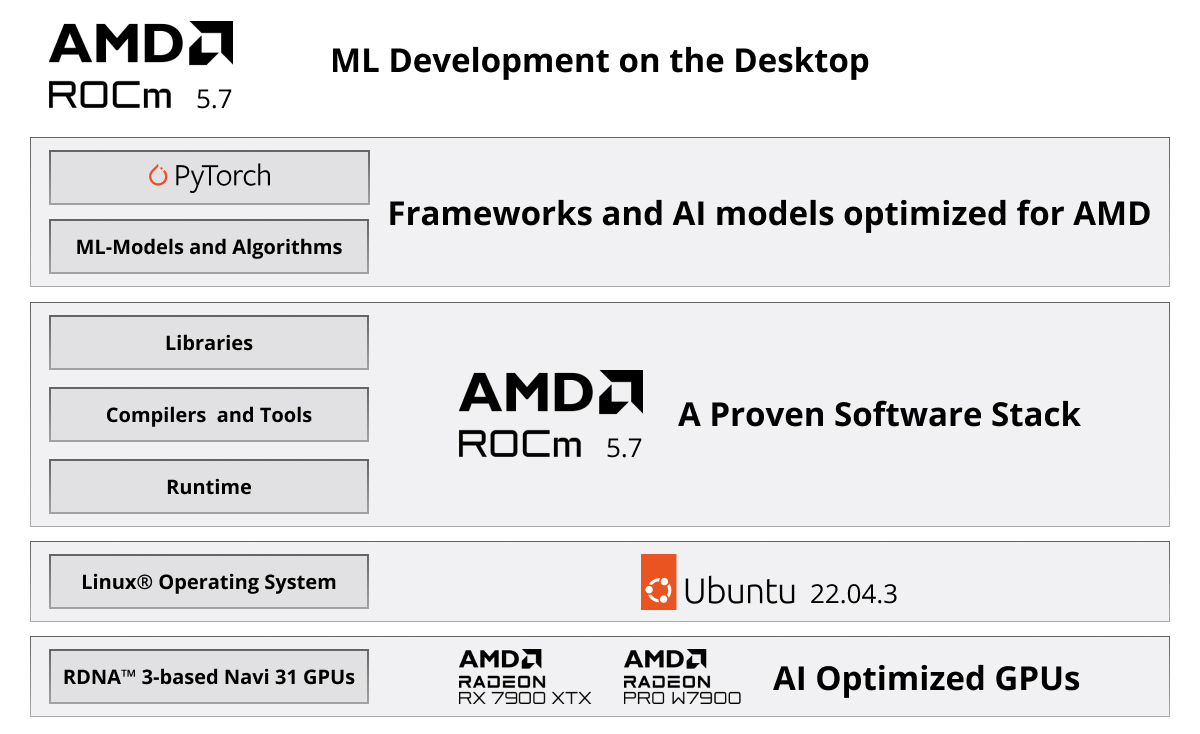Researchers and developers working with Machine Learning (ML) models and algorithms using PyTorch can now use AMD ROCm 5.7 on Ubuntu® Linux® to tap into the parallel computing power of the Radeon™ RX 7900 XTX and the Radeon™ PRO W7900 graphics cards which are based on the AMD RDNA™ 3 GPU architecture.
A client solution built on these two high-end GPUs enables a local, private, and cost-effective workflow for ML training and inference for those who previously relied on cloud-based solutions alone.

Accelerate Machine Learning With Pytorch On Your Desktop
- A local PC or workstation system running PyTorch with a Radeon 7900 series GPU presents a capable, yet affordable solution to address these growing workflow challenges thanks to large GPU memory sizes of 24GB and even 48GB.
Unified Software Stack For The Desktop And The Datacenter
- The latest AMD ROCm 5.7 software stack for GPU programming unlocks the massively parallel compute power of these RDNA™ 3 architecture-based GPUs for use with PyTorch, one of the leading ML frameworks. The same unified software stack also supports the CDNA™ GPU architecture of the AMD Instinct™ MI series accelerators.
Freedom To Customize
- The AMD ROCm platform is primarily Open-Source Software (OSS). It allows developers the freedom to customize and tailor their GPU software for their own needs while collaborating with a community of other developers, and helping each other find solutions in an agile, flexible, and rapid manner. The AMD ROCm platform’s goal is to allow users to maximize their GPU hardware investment. The AMD ROCm platform is designed to help develop, test, and deploy GPU accelerated HPC, AI, scientific computing, CAD, and other applications in a free, open source, integrated and secure software ecosystem.
As the industry moves towards an ecosystem that supports a broad set of systems, frameworks and accelerators, AMD is determined to continue to make AI more accessible to PyTorch developers and researchers that benefit from a local client-based setup for ML development using RDNA™ 3 architecture-based desktop GPUs.
Learn More
https://www.amd.com/en/developer/resources/ml-radeon.html
Download Software
https://www.amd.com/en/support/linux-drivers
Visit the Documentation Portal to get started training ML models on your local desktop
https://rocm.docs.amd.com/projects/radeon/en/latest/
Prerequisites
https://rocm.docs.amd.com/projects/radeon/en/latest/docs/prerequisites.html
How to Guide
https://rocm.docs.amd.com/projects/radeon/en/latest/docs/install/howto.html
© 2023 Advanced Micro Devices, Inc. All rights reserved. AMD, the AMD Arrow logo, CDNA, Radeon, ROCm, and combinations thereof are trademarks of Advanced Micro Devices, Inc. Linux® is the registered trademark of Linus Torvalds in the U.S. and other countries. Microsoft and Windows are registered trademarks of Microsoft Corporation in the US and/or other countries. PyTorch, the PyTorch logo and any related marks are trademarks of The Linux Foundation. TensorFlow, the TensorFlow logo and any related marks are trademarks of Google Inc. Ubuntu and the Ubuntu logo are registered trademarks of Canonical Ltd. Other product names used in this publication are for identification purposes only and may be trademarks of their respective owners.
Radeon™ AI technology is compatible with all AMD Radeon 7000 Series graphics cards and newer. Please check with your system manufacturer for feature availability prior to purchase. GD-232.
- Based on AMD internal measurements, November 2022, comparing the Radeon RX 7900 XTX at 2.5GHz boost clock with 96 CUs issuing 2X the Bfloat16 math operations per clocks vs. the RX 6900 XT GPU at 2.25 GHz boost clock and 80 CUs issue 1X the Bfloat16 math operations per clock. RX-821
